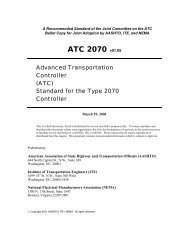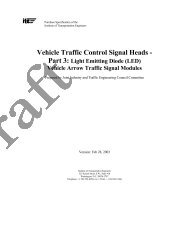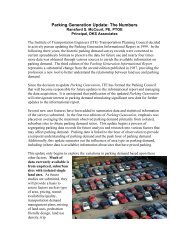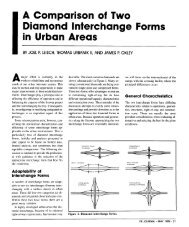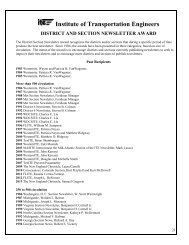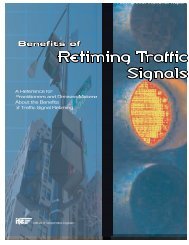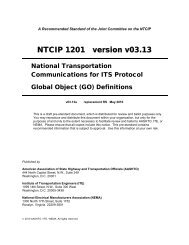Traffic Calming Liability Issues - Institute of Transportation Engineers
Traffic Calming Liability Issues - Institute of Transportation Engineers
Traffic Calming Liability Issues - Institute of Transportation Engineers
Create successful ePaper yourself
Turn your PDF publications into a flip-book with our unique Google optimized e-Paper software.
another, or to design measures for one speed versus another, is discretionary. The duty to warn<br />
motorists <strong>of</strong> traffic calming measures that require slowing down, or to maintain measures in a safe<br />
condition, or to construct measures per design specifications, is ministerial.<br />
Discretion in the Choice <strong>of</strong> Measures—Portland<br />
Under sovereign immunity, courts will not second-guess discretionary decisions <strong>of</strong> public <strong>of</strong>ficials<br />
if there is any reasonable basis for them. 6 A recent case out <strong>of</strong> Portland is most germane. A young<br />
woman died in a collision on a street that was traffic calmed farther down, but not at the accident<br />
location. While complicated by drinking and reckless driving, and by the question <strong>of</strong> whether the<br />
exact measures approved by the city council had been installed, the central issue was whether the city<br />
had done enough to prevent collisions <strong>of</strong> this type. The plaintiffs claimed that a diverter should have<br />
been used on this particular street to prevent the teenage practice <strong>of</strong> "hill jumping." Instead,<br />
following its standard planning process, the city had installed a traffic island and a couple <strong>of</strong> traffic<br />
circles many years before. The neighborhood had specifically considered and rejected a diverter.<br />
A jury found in favor <strong>of</strong> the city. The verdict is presently under appeal.<br />
One Inherently Dangerous Device—Speed Bumps<br />
There is an exception to government discretion in the choice <strong>of</strong> traffic calming measures. One<br />
physical measure has been found by some courts to be patently unsafe when applied to public streets.<br />
It is the speed bump, as opposed to the longer speed hump. 7 Speed bumps are abrupt features that<br />
rise and fall 3 to 4 inches over a span <strong>of</strong> 1 to 3 feet. Bumps have comfortable crossing speeds <strong>of</strong> 5<br />
mph or less, which relegates them to parking lots and private driveways as opposed to public<br />
roadways with their higher posted speed limits. 8 In Vickburg v. Harrellton, a landmark case , the<br />
Mississippi Supreme Court ruled that speed bumps constituted an inherent danger to motorists. The<br />
Connecticut courts reached the same conclusion, though with a different reason for declaring them<br />
a public nuisance: their low design speeds could so delay emergency vehicles as to cause serious<br />
injury or loss <strong>of</strong> life. 9 While an occasional speed bump is still found on a public road, jurisdictions<br />
using this measure are asking for legal<br />
problems.<br />
Bump Pr<strong>of</strong>ile vs. Hump Pr<strong>of</strong>ile<br />
9



